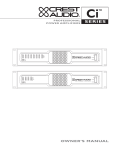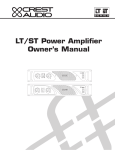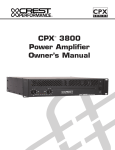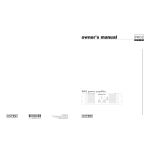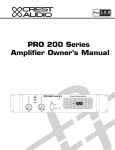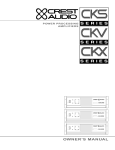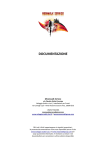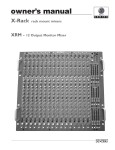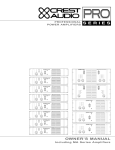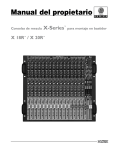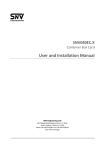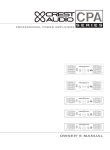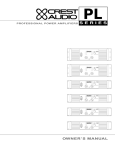Download CKi Series Owner`s Manual
Transcript
CKi Amplifier Owner’s Manual On Protect ACL ACL Off Status Ch A Ch B Remote Active Signal Signal CKi 800s Professional Power Amplifier Intended to alert the user to the presence of uninsulated “dangerous voltage” within the product’s enclosure that may be of sufficient magnitude to constitute a risk of electric shock to persons. Intended to alert the user of the presence of important operating and maintenance (servicing) instructions in the literature accompanying the product. CAUTION: Risk of electrical shock — DO NOT OPEN! CAUTION:To reduce the risk of electric shock, do not remove cover. No user serviceable parts inside. Refer servicing to qualified service personnel. WARNING:To prevent electrical shock or fire hazard, do not expose this appliance to rain or moisture. Before using this appliance, read the operating guide for further warnings. Este símbolo tiene el propósito, de alertar al usuario de la presencia de “(voltaje) peligroso” sin aislamiento dentro de la caja del producto y que puede tener una magnitud suficiente como para constituir riesgo de descarga eléctrica. Este símbolo tiene el propósito de alertar al usario de la presencia de instruccones importantes sobre la operación y mantenimiento en la información que viene con el producto. PRECAUCION: Riesgo de descarga eléctrica ¡NO ABRIR! PRECAUCION: Para disminuír el riesgo de descarga eléctrica, no abra la cubierta. No hay piezas útiles dentro. Deje todo mantenimiento en manos del personal técnico cualificado. ADVERTENCIA: Para evitar descargas eléctricas o peligro de incendio, no deje expuesto a la lluvia o humedad este aparato Antes de usar este aparato, Iea más advertencias en la guía de operación. Ce symbole est utilisé dans ce manuel pour indiquer à l’utilisateur la présence d’une tension dangereuse pouvant être d’amplitude suffisante pour constituer un risque de choc électrique. Ce symbole est utilisé dans ce manuel pour indiquer à l’utilisateur qu’il ou qu’elle trouvera d’importantes instructions concernant l’utilisation et l’entretien de l’appareil dans le paragraphe signalé. ATTENTION: Risques de choc électrique — NE PAS OUVRIR! ATTENTION: Afin de réduire le risque de choc électrique, ne pas enlever le couvercle. Il ne se trouve à l’intérieur aucune pièce pouvant être reparée par l’utilisateur. Confiez I’entretien et la réparation de l’appareil à un réparateur agréé. AVERTISSEMENT: Afin de prévenir les risques de décharge électrique ou de feu, n’exposez pas cet appareil à la pluie ou à l’humidité. Avant d’utiliser cet appareil, lisez attentivement les avertissements supplémentaires de ce manuel. Dieses Symbol soll den Anwender vor unisolierten gefährlichen Spannungen innerhalb des Gehäuses warnen, die von Ausreichender Stärke sind, um einen elektrischen Schlag verursachen zu können. Dieses Symbol soll den Benutzer auf wichtige Instruktionen in der Bedienungsanleitung aufmerksam machen, die Handhabung und Wartung des Produkts betreffen. VORSICHT: Risiko — Elektrischer Schlag! Nicht öffnen! VORSICHT: Um das Risiko eines elektrischen Schlages zu vermeiden, nicht die Abdeckung enfernen. Es befinden sich keine Teile darin, die vom Anwender repariert werden könnten. Reparaturen nur von qualifiziertem Fachpersonal durchführen lassen. ACHTUNG: Um einen elektrischen Schlag oder Feuergefahr zu vermeiden, sollte dieses Gerät nicht dem Regen oder Feuchtigkeit ausgesetzt werden.Vor Inbetriebnahme unbedingt die Bedienungsanleitung lesen. Important Safety Instructions WARNING: When using electrical products, basic cautions should always be followed, including the following: 1. 2. 3. 4. 5. 6. 7. 8. 9. 10. 11. 12. 13. 14. 15. 16. 17. Read these instructions. Keep these instructions. Heed all warnings. Follow all instructions. Do not use this apparatus near water. Clean only with a dry cloth. Do not block any of the ventilation openings. Install in accordance with manufacturer’s instructions. Do not install near any heat sources such as radiators, heat registers, stoves or other apparatus (including amplifiers) that produce heat. Do not defeat the safety purpose of the polarized or grounding-type plug. A polarized plug has two blades with one wider than the other. A grounding type plug has two blades and a third grounding plug. The wide blade or third prong is provided for your safety. If the provided plug does not fit into your outlet, consult an electrician for replacement of the obsolete outlet. Protect the power cord from being walked on or pinched, particularly at plugs, convenience receptacles, and the point they exit from the apparatus. Only use attachments/accessoriegs provided by the manufacturer. Use only with a cart, stand, tripod, bracket, or table specified by the manufacturer or sold with the apparatus. When a cart is used, use caution when moving the cart/apparatus combination to avoid injury from tip-over. Unplug this apparatus during lightning storms or when unused for long periods of time. Refer all servicing to qualified service personnel. Servicing is required when the apparatus has been damaged in any way, such as power-supply cord or plug is damaged, liquid has been spilled or objects have fallen into the apparatus, the apparatus has been exposed to rain or moisture, does not operate normally, or has been dropped. Never break off the ground pin. Write for our free booklet “Shock Hazard and Grounding.” Connect only to a power supply of the type marked on the unit adjacent to the power supply cord. If this product is to be mounted in an equipment rack, rear support should be provided. Exposure to extremely high noise levels may cause a permanent hearing loss. Individuals vary considerably in susceptibility to noise-induced hearing loss, but nearly everyone will lose some hearing if exposed to sufficiently intense noise for a sufficient time. The U.S. Government’s Occupational and Health Administration (OSHA) has specified the following permissible noise level exposures: Duration Per Day In Hours 8 6 4 3 2 1 1/2 1 1/2 1/4 or less Sound Level dBA, Slow Response 90 92 95 97 100 102 105 110 115 According to OSHA, any exposure in excess of the above permissible limits could result in some hearing loss. Ear plugs or protectors to the ear canals or over the ears must be worn when operating this amplification system in order to prevent a permanent hearing loss, if exposure is in excess of the limits as set forth above. To ensure against potentially dangerous exposure to high sound pressure levels, it is recommended that all persons exposed to equipment capable of producing high sound pressure levels such as this amplification system be protected by hearing protectors while this unit is in operation. SAVE THESE INSTRUCTIONS ! Table Of Contents 1 2 How To Use This Manual . . . . . . . . . . . . . . . .p.2 Introduction Conventions 3 Features Overview . . . . . . . . . . . . . . . . . . . . .p.7 4 Modes . . . . . . . . . . . . . . . . . . . . . . . . . . . . . . .p.13 Installation . . . . . . . . . . . . . . . . . . . . . . . . . . . .p.3 Unpacking Mounting Cooling Requirements Circuit Size Requirements PowerSave Maintenance Front Panel Side Panel Rear Panel Stereo Parallel Bridged Constant Voltage 5 Operation . . . . . . . . . . . . . . . . . . . . . . . . . . . .p.15 6 Safety . . . . . . . . . . . . . . . . . . . . . . . . . . . . . . . .p.21 7 NexSys Modules . . . . . . . . . . . . . . . . . . . . . . .p.25 8 Service, Support & Warranty . . . . . . . . . . . . .p.34 a b c d Specifications . . . . . . . . . . . . . . . . . . . . . . . . . .p.35 Contents Power Input Output STO User Responsibility Speaker Protection Protection Circuitry Introduction Installation Module Features Module Operation Support Contact Crest Warranty Constant Voltage . . . . . . . . . . . . . . . . . . . . . . .p.36 Network Reference . . . . . . . . . . . . . . . . . . . .p.37 Appendices Wire Gauge Chart . . . . . . . . . . . . . . . . . . . . .p.38 p.1 1 How to use this manual Introduction Congratulations on your purchase of a Crest Audio CKi Intelligent Power Processing amplifier. Please read this manual carefully as it contains information vital to the unit’s safe operation. Also, please fill out and return the enclosed product registration card. CKi amplifiers represent a new level of value and flexibility never before offered to the contracting market. S Series models are designed to drive low impedance speaker loads while V Series models feature a unique front end circuit to provide directly coupled 70.7 volt outputs, eliminating the need for step-up transformers. X Series models feature transformer-isolated outputs for 100V operation (50V optional). Together, these amplifiers cover almost every conceivable installed or distributed sound power requirement.The CKi family is everything that you expect from Crest Audio.They are ruggedly built from high quality components, intelligently laid out, and possess comprehensive protection features. After-sale support is considered paramount at Crest Audio. For any assistance in the set-up or operation of this product please call Crest Audio’s Customer Service department or your local Crest Audio representative. Should you have any problems at all, or suggestions that may help us improve our products or service, please contact us.We encourage your participation in Crest’s future. FOR YOUR SAFETY, READ THE IMPORTANT PRECAUTIONS SECTION AS WELL AS THE INPUT, OUTPUT AND POWER CONNECTION SECTIONS OF THIS MANUAL. Conventions Warnings a Procedures not to attempt. Issues or hazards to keep in mind when operating the equipment. Indicators What to look for on the equipment display. Alerts, indicators, or prompts that may appear. ® Tips Preferred methods. Helpful hints. Feature insights. + See See—refers to other sections of the manual containing supplementary information on the current topic or a related issue Note Note—supplementary feature information p.2 Installation 2 / What to do with the shipping carton / Proper rack-mounting technique / Keeping the amplifier cooled / Supplying proper power / Saving power / Routine maintenance practices Unpacking Mounting Cooling Requirements Circuit Size Requirements PowerSave Maintenance p.3 2 Installation Unpacking Upon unpacking, inspect the amplifier. If you find any damage, notify your supplier immediately. Only the consignee may institute a claim with the carrier for damage incurred during shipping. Be sure to save the carton and all packing materials. Should you ever need to ship the unit for any reason, use only the original factory packing. If the shipping carton is unavailable, contact Crest to obtain a replacement. + For replacement packaging, call Crest Audio’s Customer Service Department directly. see—service and support Mounting Crest Audio CKi amplifiers are configured to a standard set-up at the factory.They are functional and ready to use ‘out of the box.’ All controls and input/output connections are clearly labeled. Units are shipped standard with a blank panel in the module bay. To set the amplifier up for basic usage: 1. Mount the amplifier in a rack, remembering to allow for adequate access and cooling space. See - Cooling Requirements below for more information. 2.Make input connections via the rear-panel Phoenix connector inputs.Make the connections to both inputs (Ch A and Ch B) for stereo operation, or connect to Ch A only for parallel or bridged mono configuration. See - Chapter 4 Modes for more information. 3. Connect speakers to the output barrier strip. Be sure to make the correct output connections for stereo, parallel or bridged mono configuration. See - Chapter 5 Operation for more information. 4. Make power connections, allowing for proper current draw. See - Chapter 5 Operation for more information on power considerations. 5.Turn the front panel three-position AC switch to 'on', and bring up the rear panel gain attenuators to the desired level. a CKi Power Processing amplifiers are 2, 3 & 4-rack space units of 17 1/8" (437mm) depth that mount in a standard 19-inch rack. On 2 &3 rack space units, four front panel-mounting holes are provided. 4-rack space units have eight front panel-mounting holes. Rear mounting ears are also provided on all amplifiers for additional support, which is essential in non-permanent installations like mobile or touring sound systems, and recommended for permanent installations. (Distance from the back of the front rack ear to the center of the rear mounting ear holes is 16 5/8" / 422mm) Because of the cables and connectors on the rear panel, a right-angle or offset screwdriver or hex key will make it easier to fasten the rear mounting ears to the rails p.4 Be certain that there is enough space around the the amplifier to allow the heated air to escape.When mounting in a rack, try to avoid using doors or covers on the front and rear of the enclosure; the exhaust air must not be impeded In racks with closed backs allow at least one standard-rack-space opening for every four amps. Installation 2 Front View 19” (483mm) ACL ACL Ch A Ch B Active Signal Signal CKi 100s Remote Professional Power Amplifier 3.5” (89mm) Protect Status 5.25” (133mm) 7” (178mm) On Off Rear View 17” (432mm) V-In Fault B + O n Co m O ff O n Co m O ff 3. 3 In V p G ut nd N /O Co m N /C Sequential Turn-On + + -10 Stereo Active In Out In Out Output - Class 2 Wiring -6 -15 Parallel - Mode -10 Ch A A -6 -3 -15 -1 -30 dB -30 Bridge -3 -1 dB Ch B Protect IGM ACL Signal B Ch A + Ch B + (.775V) 0dB x20 Input x40 3.5” (89mm) AB A 5.25” (133mm) 7” (178mm) Designed and manufactured in the USA by: Crest Audio, Inc. Fair Lawn, NJ USA www.crestaudio.com Gain Side View 17.1” (435mm) 3.5” (89mm) 5.25” (133mm) 7” (178mm) p.5 2 Installation Cooling Requirements CKi amplifiers use a forced-air cooling system to maintain a low, even operating temperature.Air drawn by a fan mounted behind the front panel enters through the front grille and the heated air exits through the side panel ports. On two an three space CKi amplifiers the fan will remain inactive until operating temperature rises to 45° C. One four space units the fan runs all the time. Make sure that there is enough space around the front of the amplifier to allow air to enter, and around the sides to allow the heated air to exit. System cooling needs must be considered before installation, and the system installer/designer should specify appropriate countermeasures, such as ventilation, air conditioning, etc. Refer to Appendix A for specific thermal emission figures. Note: If the amplifier is rack-mounted, do not use doors or covers on the front or rear without pressurizing the rack. Make sure that heated air can escape freely, and that there is no resistance to the intake of cool air. Intake and exhaust air must flow without restriction. Fan filters should be regularly cleaned and periodically replaced. Circuit Size Requirements CKi amplifier power requirements are rated at “idle,” 1/8th power (“typical” music conditions), 1/3rd power, and maximum rated power.The maximum power current draw rating is limited by the amplifier's circuit breaker. Consult Appendix A for the current that each amplifier model will demand.AC mains voltage must be the same as that indicated on the rear of the amplifier. Damage caused by connecting the amplifier to improper AC voltage is not covered by any warranty. PowerSave All CKi amplifiers come standard with PowerSave circuitry.This effectively reduces current draw and thermal emissions to a minimum when the amplifier is at idle. PowerSave operates by cutting off the bias current to the output stage after absence of signal is sensed at the input.When signal presents itself, PowerSave instantly restores the bias current after the first positive-going waveform. Current draw specifications while PowerSave is active are included in specifications under "Idle Current Draw." Maintenance CKi amplifiers require little routine maintenance. When used in an extremely dusty or smoky environment, the unit should be periodically blown free (using compressed air) of any foreign matter that may have built up inside. When used in an environment where residue from smoke/fog machines is regularly present, the amplifier(s) should be periodically checked (by authorized Crest service personnel) for build-up of that residue. The filter in the front panel air intake grille should be periodically cleaned. Should the filter become permanently clogged or damaged, a replacement should be obtained through your Crest representative Users will not need to make any adjustments to the amplifier during its lifetime. Other than installing or replacing a NexSys module, there are no user-serviceable parts or adjustments that require opening the unit. p.6 + Always turn off and disconnect the amplifier from the mains voltage before making audio connections. If possible, as an extra precaution, have the attenuators turned down during power-up. Features Overview 3 / Controls and connectors / Legend of panel symbols / Air flow Front Panel Side Panel Rear Panel p.7 3 Features Overview This chapter identifies the switches, indicators, connectors and functional components of all CKi amplifiers. Keep in mind that this chapter is only as an overview of the amplifier’s layout, and does not contain all the information necessary to effectively operate the CKi. For more detailed information on the items listed here, be sure to read this entire manual. Front Panel - CKi 800s shown 1 2 3 4 5 6 On Protect ACL ACL Off Status Ch A Ch B Remote Active Signal Signal 7 CKi 800s Front Panel 1 Rack Mounting Ears Two holes (four on 4U amplifiers) are provided on each front mounting ear.. 2 3-Position Power Switch With this switch in the “up” position the amplifier is On.The middle position is Off and the lower position is marked Remote. When switched to Remote, the amplifier must be activated by the sequential turn on/turn off (STO) circuit. 3 Protect LED If the amplifier enters any of its Protect modes, the output relay will open, and this LED will light. 4 Active LED The Active LED indicates the amplifier is turned on and the output relays have closed. 5 ACL LEDs Each channel has an ACL (Active Clip Limiting) LED. If a channel reaches the clipping point, this LED will light to show that the ACL circuit is active. p.8 Professional Power Amplifier Features Overview 3 Front Panel cont. 6 Signal LEDs Each channel has a Signal LED.The intensity of the light varies with signal level – the stronger the input signal, the brighter the LED. 7 Fan Grille & Filter A DC fan draws air into the amplifier though the removable dust filter. Do not block this intake! The fan operates only when the amplifier requires cooling. Fan filters are easy to remove and should be cleaned regularly to ensure optimum performance. Contact your Crest Representative to obtain replacement filters. Side Panel 1 Exhaust Ports Heated air exits through the exhaust ports, on the sides of the amplifier chassis. Do not block these ports. 1 Warm Air Warm Air Side View p.9 3 Features Overview Rear Panel - CKi 100s shown 1 8 6 2 Designed and manufactured in the USA by: Crest Audio, Inc. Fair Lawn, NJ USA www.crestaudio.com AB A V-In Fault B + O n Co m O ff O n Co m O ff 3. 3V In p G ut nd N /O Co m N /C Sequential Turn-On + + -10 Active Out 3 4 In Out Output - Class 2 Wiring 5 Parallel - Mode 7 9 Rear Panel 1 Mains Breaker -10 Ch A 0 Protect IGM ACL Signal ¡ B Ch A + Ch B + (.775V) 0dB x20 x40 Input Gain 12 13 Rear Panel Legend Ground Connected Ground Lifted 2 IEC Power Cord Connector Channel A stereo/parallel On 2U amplifiers, a standard IEC power connector is located on the rear panel of amplifier.The connector accommodates a standard IEC line cord, included in the amplifier box. Should this cord need to be replaced, only a cord with the same current rating should be used. 3U & 4U units have a captive power cord. The AC mains yellow LED indicates that the amplifier is attached to a power source.The active green LED indicates that the amplifier has been turned on and is operating. -3 -1 dB Ch B 2U & 3U amplifiers have a push-type circuit breaker, while 4U units have a throw-switch style breaker. If the unit’s breaker trips repeatedly, the amplifier needs servicing. 3 AC Mains / Active LED indicators A -6 -3 -15 -1 -30 dB -30 Bridge In -6 -15 Stereo Bridged mono Channel B stereo/parallel + Input Polarity 4 Sequential turn on/off Connectors These connectors can be wired to a contact closure for remote turnon and to other CKi amplifiers for sequential turn-on (STO). 5 Fault I/O Connector This output is a contact closure that can be used to report a fault condition (e.g. an open output relay) in the amplifier. p.10 Never connect a hot (red) output to ground or to another hot (red) output! a Features Overview 3 Rear Panel cont. 6 Output Connectors A barrier strip provides output connection terminals for two speakers operating in stereo or parallel, for a single speaker wired in a bridged mono configuration,or for constant voltage distribution.Bare wire or spade lugs may be used to make barrier strip connections. 7 Ground Lift Switch This switch disconnects the audio ground from the chassis ground in the amplifier. 8 Module Bay All CKi amplifiers possess a module bay configured to accept interchangeable plug-in modules. Your amplifier may have been factory configured with a module. Information on all CKi modules is available in this manual. See – Chapter 7 NexSys Modules for more information. a Do not adjust the mode selection switch while the amplifier is turned-on. 9 Mode Select Switch This switch reconfigures the amplifiers outputs for stereo, parallel, or bridged operation.. 0 Input Attenuators Each channel has an attenuator knob to adjust the channel’s output from -∞ to maximum power. ¡ Status LEDs The “Protect,” “Signal,” and “ACL” LED’s on the rear panel serve the same function as the front panel LED’s of the same names.The “IGM” LED will light if the amplifier’s IGM protection circuit engages. 12 Input Connectors The CKi uses one 3-pin Phoenix connector per channel for balanced line-level audio input. These inputs can also be setup to accept an unbalanced signal. 13 Gain (input sensitivity) Select Switch This switch sets the amplifier’s gain structure as constant sensitivity (0dB setting) or constant gain (x20 or x40 settings). + In situations where an UNBALANCED signal is fed to the amp, it’s important to ground the unused input. If the inverting (-) input of an amp channel is left floating, the gain will drop by 3 dB. p.11 Modes / Choosing the appropriate mode / Switching between operation modes / Special considerations when using bridged mode / Connecting to a constant voltage Line 4 Stereo Parallel Bridged Constant Voltage p.13 4 Modes Mode Selection The rear panel Mode Select Switch determines whether the amplifier is in stereo, parallel or bridged mono mode. Do not operate the Mode Select Switch with the amplifier on. See the next chapter on Operation for proper wiring in each mode. Stereo For stereo (dual channel) operation, turn the amplifier off and set the Mode Select Switch to the stereo position. In this mode, both channels operate independently of each other, with the input attenuators controlling each channel’s level. Thus, a signal at Channel A’s input produces an amplified signal at Channel A’s output, and the same for Channel B. -15 Stereo -3 Bridge Parallel Mode Parallel For parallel (dual-channel/single input) operation, turn the amplifier off and set the Mode Select Switch to the parallel position; both amplifier channels will now be driven by the signal at Channel A’s input. No jumper wires are needed. Output connections are the same as in the stereo mode. In the parallel mode, only Channel A’s input is active; Channel B’s input is not in the circuit. Both attenuators remain active, permitting different levels for each channel. Power and other performance specifications are the same as in the stereo mode. a Connecting amplifier outputs to oscilloscopes or other test equipment while the amplifier is in bridged mode may damage both the amplifier and test equipment! Bridged Mono For Bridged (single channel/single input) operation, turn the amplifier off and set the Mode Select Switch to the Bridge position. This Mode straps both amplifier channels together, making a very powerful single channel. One channel “pushes” and the other “pulls” equally, effectively quadrupling the power of either channel alone.As in Parallel mode, signal is connected to Channel A. The nature of Bridged mode requires that both attenuators be set at the same level, preferably at 0dB attenuation.The speakers are connected only to the designated “+” output terminals. Use extreme caution when operating in the bridged mode, as potentially lethal voltage may be present at the output terminals. Unlike the stereo and parallel modes, in which one side of each output is grounded, both sides are hot in bridged mono mode. Channel A’s side is the same polarity as the input. Never ground either side of the speaker cable when the amplifier is in bridged mono mode; both sides are “hot.” If an output patch panel is used, all connections must be isolated from each other and from the panel. Constant Voltage CKi-V and CKi-X Series amplifiers are designed for use with distributed or constant voltage systems. These amplifiers can also be wired for Bridged Mono mode operation, however, bridging these models is usually undesirable, as the output will be approximately 140V (CKi-V) or 200V (CKi-X) There are, however, specific applications for this configuration. Contact Crest Audio Customer Service for more information if required. See – Appendix B for information on recommended distributed line impedance. p.14 Regardless of operating mode, NEVER connect amplifier outputs directly together! a Operation 5 / Connecting the amplifier to AC power / Proper signal paths / Proper wiring schemes for output connectors / Sequential turn on/off / Additional operation considerations Power Input Output STO p.15 5 Operation Power Unless otherwise specified when ordered, CKi Series amplifiers are shipped from the factory set to one of following voltage options: Option 1 US domestic Nominal 120Vac 60Hz for rated power output (safe operating range 100 - 132Vac ) Option 2 Export Nominal 230Vac 50Hz for rated power output (safe operating range 200 - 264Vac ) Inputs All CKi series amplifiers use 3-Pin Phoenix connectors for attaching input signals. Each connector is configured (from left to right) positive, negative, ground. Input Phoenix Connectors Ch A + Ch B + + In situations where an UNBALANCED signal is fed to the amp, it’s important to ground the unused input. If the inverting (-) input of an amp channel is left floating, the gain will drop by 3 dB. Outputs Direct Direct (speaker) outputs are connected to CKi series amplifiers via the rear-panel terminal strips. Be sure to properly calculate the total impedance of all speakers connected to a direct output and to not exceed the minimum impedance rating of your CKi amplifier Constant Voltage For CKi-v and CKi-x models constant voltage (distributed) lines are connected to via the same rear-panel terminal strips. Be sure to properly calculate the total wattage demand of each constant voltage line and to not exceed the maximum output rating of your CKi amplifier. Output Barrier Strip AB A + + B + See — the wiring diagrams on the next two pages for more information on connecting your CKi amplifier. p.16 Very high current is available at the outputs. Please connect your output cable to the + and - terminals of each section precisely as shown. a Operation 5 Stereo Mode Direct Outputs Designed and manufactured in the USA by: Crest Audio, Inc. Fair Lawn, NJ USA www.crestaudio.com Nx Ethernet I.P. Address Amp ID Gain Temperature AC Voltage AB A V-In Fault Edit Select Function In Out Output - Class 2 Wiring -15 Mode A -6 -10 -3 -15 -1 -30 dB -30 Parallel - Bridge Out -6 -10 Stereo Active In Fault Mute Data Link B + O n Co m O ff O n Co m O ff 3. 3 In V p G ut nd N /O Co m N /C Sequential Turn-On B + + Ethernet A -3 -1 dB Protect IGM ACL Signal B Ch A + (.775V) 0dB x20 Ch B Ch A Ch B + x40 Gain Input A B + Ch. B Ch. A + Parallel Mode Direct Outputs Designed and manufactured in the USA by: Crest Audio, Inc. Fair Lawn, NJ USA www.crestaudio.com Nx Ethernet I.P. Address Amp ID Gain Temperature AC Voltage AB A V-In Fault B Edit Select Function Active Out Output - Class 2 Wiring Mode Fault Mute Data Link B -3 -1 dB Protect IGM ACL Signal B Ch A + Ch B + (.775V) 0dB x20 Ch B Ch A x40 Gain Input + Ch. A B A In Parallel - A -6 -10 -3 -15 -1 -30 dB -15 -30 Bridge Out -6 -10 Stereo In A + O n Co m O ff O n Co m O ff 3. 3V In p G ut nd N /O Co m N /C Sequential Turn-On + + Ethernet Bridged Mono Mode Direct Outputs Designed and manufactured in the USA by: Crest Audio, Inc. Fair Lawn, NJ USA www.crestaudio.com Nx Ethernet I.P. Address Amp ID Gain Temperature AC Voltage AB A V-In Fault + + B Edit Select Function -10 Stereo Active Out In Out Output - Class 2 Wiring -6 Mode -10 Ch A A -6 -3 -15 -1 -30 dB -15 -30 Parallel - Bridge In Fault Mute Data Link B + O n Co m O ff O n Co m O ff 3. 3 In V p G ut nd N /O Co m N /C Sequential Turn-On Ethernet A -3 -1 dB Ch B Protect IGM ACL Signal B Ch A + Ch B + (.775V) 0dB x20 Input x40 Gain Ch. A + Bridged p.17 5 Operation Stereo Mode Constant Voltage Output (V & X Models only) Designed and manufactured in the USA by: Crest Audio, Inc. Fair Lawn, NJ USA www.crestaudio.com Nx Ethernet I.P. Address Amp ID Gain Temperature AC Voltage AB A V-In B + + Fault Edit Select Function -10 Stereo Active Out In Out Output - Class 2 Wiring -6 -15 Mode -10 A -6 -3 -15 -1 -30 dB -30 Parallel - Bridge In Fault Mute Data Link B + O n Co m O ff O n Co m O ff 3. 3 In V p G ut nd N /O Co m N /C Sequential Turn-On Ethernet A -3 -1 dB Protect IGM ACL Signal B Ch A + (.775V) 0dB x20 Input Ch B Ch A Ch B + x40 Gain + + Ch. B Ch. A CV Line Ch. B CV Line Ch. A Parallel Mode Constant Voltage Output (v & x Models only) Designed and manufactured in the USA by: Crest Audio, Inc. Fair Lawn, NJ USA www.crestaudio.com Nx Ethernet I.P. Address Amp ID Gain Temperature AC Voltage AB A V-In + + Fault Edit Select Function -10 Stereo Active Out In Out Output - Class 2 Wiring CV Line Ch. A -6 Mode -10 Ch A A -6 -3 -15 -1 -30 dB -15 -30 Parallel - Bridge In Fault Mute Data Link B + O n Co m O ff O n Co m O ff 3. 3 In V p G ut nd N /O Co m N /C Sequential Turn-On B Ethernet A -3 -1 dB Ch B Protect IGM ACL Signal B Ch A + Ch B + (.775V) 0dB x20 x40 Gain Input CV Line Ch. B Removable Attenuator Knobs The attenuator knobs can be removed and replaced with plugs that are shipped with the amplifier.The procedure for attenuator knob removal is as follows: 1.With a small knife, remove the gray key cap of the attenuator knob revealing the inside nut. 2. Using needle nose pliers or an appropriately sized nut driver, loosen the nut. 3. Slide the attenuator knob off the shaft. 4. Insert a regular screwdriver in the slotted end of the shaft and adjust attenuation to the desired level. 5. Insert the blank plugs into the attenuator holes. p.18 Ch. A + Ch.A - Knob still attached Ch. B - Knob replaced with plug -10 -6 -15 -10 -6 -3 -15 -1 -30 dB -30 llel - Ch A -3 -1 dB Ch B Operation 5 Gain Select Switch The 3-position gain select switch on the rear panel to sets the overall gain of the amplifier.The left and right switch positions set the amplifier for constant gain of x20 (26 dB) or x40 (32 dB) respectively.The center position sets the amplifier for constant sensitivity. In this position, a 0dBu (0.775 VRMS) input signal will produce maximum power at the amplifier’s output.The standard factory setting is for x40 (32dB).The specifications for a specific CKi models in Appendix A contain more gain/sensitivity information. (.775V) 0dB x20 x40 Gain Signal Ground Lift Switch The signal source equipment should share the same AC ground as the amplifier(s). In some cases, however, particularly if an amplifier is being installed in an existing system, this may result in a ground loop, creating excessive 60Hz hum at the amplifier’s output. If this happens, slide the ground lift switch on the amplifier’s rear panel to the “open” (left) position. In this position, the signal ground is lifted from the chassis ground and is clamped to ± 0.6V. Do not lift the ground if the amplifier and the signal source equipment are not on the same AC ground! In a properly designed system, the amplifier should receive its ground from the AC line cord to ensure safety and minimize noise. Sequential Turn On/Off (STO) CKi amplifiers come standard with Sequential Turn-On/Turn-Off (STO) circuitry.When the amplifier front power switch is set to “remote,” a single SPDT toggle switch or two SPST momentary switches can be used to turn the amplifier on and off. Using the same switch(es), additional amplifiers can be turned on/off sequentially by daisy chaining the STO "Out" terminals of one amplifier to the STO "In" terminals of a subsequent amplifier.The standard turn-on delay time between amplifiers is approximately 100ms; turn-off delay time is 200ms. When using NexSys control with an amplifier equipped with an NxEthernet or NxCobraNet module, these standard turn-on and turn-off delay times may be modified in the control software. Standard Sequential Turn-On/Turn-Off Wiring For non-NexSys remote turn-on, a single SPDT toggle switch or two SPST momentary switches can be used. In either case, the switch(es) are wired to the “STO In” connector on the amplifier’s rear panel and the amplifier’s front panel power switch must be set to “Remote.” The switch(es) should be wired to close a connection between “Com” and “On” pins for turn-on, and between the “Com” and “Off” pins for turn-off. The diagram below illustrates the circuit: V-In Fault + + When using NexSys control, hardwiring for manual switch closure between amplifiers should be used cautiously. If the switch closure output is wired up, it WILL cause the next amp to switch, regardless of which source (hardware switch or NexSys STO command) has initiated the command. + O n Co m O ff O n Co m O ff 3. 3 In V p G ut nd N /O Co m N /C Sequential Turn-On a The shield on a balanced input line should be grounded at one end only (usually the sending end), and it must never be relied on to supply AC ground to the amplifier. Active In Out In Out Output - Class 2 Wiring On Off p.19 5 Operation STO Daisy Chaining Any number of CKi amplifiers can be daisy-chained together for sequential turn-on.Wiring two amplifiers for STO is as simple as connecting the “On,” “Com” and “Off” pins of the “STO Out” connector on the first amplifier to the corresponding pins on the “STO In” connector on the second amplifier. Repeating this wiring scheme with subsequent amplifiers allows entire systems of CKi’s to be wired for STO. Designed and manufactured i Crest A Fair La www.c AB A V-In Fault + O n Co m O ff O n Co m O ff 3. 3 In V p G ut nd N /O Co m N /C Sequential Turn-On + + Active In Out In Out Output - Class 2 W Designed and manufactured i Crest A Fair La www.c Modules AB A CKi amplifiers come standard with a blank panel fixed over the module bay. When a NexSys module is installed in this bay, connection to a network is made via a standard RJ-45 connector and CAT-5 Ethernet cable. Module Removal/Installation The amplifier must be switched off and unplugged from the AC mains supply before any module operation is undertaken. Two Phillips head screws secure the module/panel to the chassis.The module is connected electrically to the amplifier with a single multi-pin ribbon cable. Once unscrewed from the chassis, unplugging the module from this ribbon cable frees the module for removal.To insert a module, simply reverse this procedure. V-In Fault + O n Co m O ff O n Co m O ff 3. 3 In V p G ut nd N /O Co m N /C Sequential Turn-On + + Active In Out In Out Output - Class 2 W On Off a Standard CKi Power Processing amplifiers come with a blank panel installed in the Network bay.The amplifier must not be operated without a Network module or blank panel in place. See – Chapter 7 NexSys Modules for more information Module Bay with Blank Panel Installed Designed and manufactured in the USA by: Crest Audio, Inc. Fair Lawn, NJ USA www.crestaudio.com AB A B + N /O Co m N /C Fault + + -10 Stereo Out Output - Class 2 Wiring -6 -15 -10 Parallel - Mode A -6 -3 -15 -1 -30 dB -30 Bridge -3 -1 dB Protect IGM ACL Signal B Ch A + (.775V) 0dB x20 Input Ch B Ch A Ch B + x40 Gain Removable modules contain static-sensitive devices; handle modules only at static-safe workstations! Module Bay with Nx Ethernet Module Installed Designed and manufactured in the USA by: Crest Audio, Inc. Fair Lawn, NJ USA www.crestaudio.com Nx Ethernet I.P. Address Amp ID Gain Temperature AC Voltage AB A + + B Edit Select Function -10 Stereo p.20 Output - Class 2 Wiring -6 -15 Mode -10 Ch A A -6 -3 -15 -1 -30 dB -30 Parallel - Bridge Out Fault Mute Data Link B + N /O Co m N /C Fault Ethernet A -3 -1 dB Ch B Protect IGM ACL Signal B Ch A + Ch B + (.775V) 0dB x20 Input x40 Gain a Safety / The owner’s role in amplifier safety / Protecting your speakers / Description of protection features 6 User Responsibility Speaker Protection Protection Features p.21 6 Safety User Responsibility Your CKi Series amplifier is very powerful and can be potentially dangerous to loudspeakers and operators alike. It is your responsibility to read all precautions and make sure that the amplifier is installed, wired, and operated properly as instructed in this manual. Many loudspeakers can be easily damaged or destroyed by overpowering, especially with the high power available from a bridged amplifier. Always be aware of the speaker’s continuous and peak power capabilities. Crest Audio is not responsible for damage to loudspeakers for any reason. Speaker Protection All loudspeakers have electrical, thermal and physical limits which must be observed to prevent damage or failure. Too much power, severely clipped wave forms, low frequencies applied to high frequency drivers and DC voltage can all be fatal to cone and compression drivers. Crest Audio CKi Series amplifiers automatically protect speakers from DC voltages and subsonic signals. Be sure that the low and mid bands of an electronic crossover are connected to the correct amplifiers and drivers, and not accidentally connected to those for a higher frequency band. The amplifier’s clipping point is its maximum peak output power, and some of the higher-powered CKi Series amplifiers can deliver more power than many speakers can safely handle. Be sure the peak power capability of the amplifier is not excessive for your speaker system. To ensure the speakers never receive excessive power and that the amplifier never clips, use a properly adjusted external limiter (or a compressor with a ratio of 10:1 or higher) to control power output; in systems with active electronic crossovers, use one for each frequency band. The clip limiter will automatically limit the duration of squared-off, continuous wave forms applied to the speakers.The amplifier will, however, allow normal musical transient bursts to pass. When the amplifier does clip, it is at its maximum output power. Some speaker systems are packaged with processors that have power limiting circuits and should not require additional external limiting. Fuses may also be used to limit power to speaker drivers, although as current-limiting rather than voltage limiting devices. Some poor quality fuses have a significant series resistance that could degrade the amplifier’s damping of the speaker’s motion and may even deteriorate the system’s sound quality. If you elect to use fuses, check with the speaker manufacturer to determine the proper current rating and time lag required. Do not drive any low frequency speaker enclosure with frequencies lower than its own tuned frequency; the reduced acoustical damping could cause a ported speaker to bottom out even at moderate power. Consult the speaker system specifications to determine its frequency limits. The wire gauge charts in Appendix D will assist you in determining the optimum copper wire gauge for speaker cables in direct output systems. Speaker cable resistance robs amplifier power in two ways: through power lost directly to resistance (often referred to as I2R loss), and through increased total load resistance, which decreases the amount of power available from the amplifier. Appendix D gives cable length figures in feet/AWG wire gauges and in metric values. p.22 Safety 6 Protection Features CKi Series amplifiers incorporate several circuits to protect both themselves and loudspeakers. Crest Audio has attempted to make the amplifiers as foolproof as possible by making them immune to short and open circuits, mismatched loads, DC voltage and overheating. If a channel goes into ACL gain reduction mode, the speaker load will remain connected but clipping percentage or output power will be instantly reduced. When a problem occurs that causes a channel to go into a protection mode, the Protect LED for that channel will glow. DC voltage on the output, excessive subsonic frequencies or thermal overload will cause the channel’s output relay to open, disconnecting the speaker load until the condition is corrected. Automatic Clip Limiting (ACL) Any time a channel is driven into continuous clipping, the clip limiter circuit will reduce the channel gain to a level just slightly into clipping, which protects the speakers against the damaging, high power, continuous square waves. Situations that may activate the clip limiter include uncontrolled feedback, oscillations, and improper equipment setting or a malfunction upstream from the amplifier. Normal program transients will not trigger the clip limiter; only steady, excessive clipping will. The ACL LED will glow brightly and continuously when limiting occurs. IGM Impedance Sensing CKi Series amplifiers feature innovative circuitry that allows safe operation into any load. When an amplifier sees a load that overstresses the output stage, the Instantaneous Gain Modulation (IGM) circuit adjusts the channel gain to a safe level. This method of output stage protection is far superior to the conventional, brute force-type limiting found on other amplifiers. The IGM circuit is sonically transparent in normal use and unobtrusive when activated. Thermal Protection The internal fan will keep the amplifier operating well within its intended temperature range under normal conditions. If a channel’s heat sink temperature reaches 75°C (which may indicate an obstructed air supply), that channel will independently protect itself by disconnecting its load and shutting down until it has cooled. During this time, the Protect LED will light, the Active LED will extinguish and the cooling fan will run at its highest speed. Short Circuit If an output is shorted, the IGM and thermal circuits will automatically protect the amplifier. The IGM circuit senses the short circuit as an extremely stressful load condition and attenuates the signal, protecting the channel’s output transistors from over-current stress. If the short circuit remains, the channel will eventually thermally protect itself by disconnecting the load. DC Voltage Protection If an amplifier channel detects DC voltage or subsonic frequencies at a channel output,the respective output relay will immediately open to prevent loudspeaker damage.The Protect DC LED will light. p.23 6 Safety Turn-On/Turn-Off Protection At power-up, the amplifier stays in the protect mode with outputs disconnected for about six seconds, while the power supplies charge and stabilize. While the output relays are open, the ACL LEDs will light. When the power is turned off, the speaker loads immediately disconnect so that no thumps or pops are heard. Auto Ramp Signal Control Whenever a CKi Series amplifier powers up or comes out of a protect mode, the Auto Ramp circuit activates. While the speakers are disconnected, the Auto Ramp circuit fully attenuates the signal. After the output relay closes, the signal slowly and gradually raises up to its set level. PowerSave All CKi amplifiers come standard with PowerSave circuitrywhich reduces current draw and thermal emissions at idle. PowerSave operates by cutting off the bias current to the output stage when signal is no longer sensed at the input.When signal appears,bias current is instantl;y restored after the first positive-going waveform. Current draw specifications while PowerSave is active are included in specifications under "Idle Current Draw." NexSys Fault Monitoring A CKi equipped with an NxEthernet or NxCobraNet module and connected to a NexSys network will report fault conditions to the PC controlling the network. If a networked amplifier enters ACL or IGM or experiences a thermal, DC voltage, or short circuit fault, the fault condition will be reported the PC interface.This allows easy monitoring of amplifier operating conditions across a large or widespread network from a single location. p.24 NexSys Modules 7 / General module information / Installing a module / Individual module features / Using a module / Setting amplifier IDs / Amplifier monitoring via modules Overview Installation Features Operation Amplifier ID Condition Monitoring p.25 7 NexSys Modules Overview The extended capabilities of CKi amplifiers are reached when connected to a NexSys amplifier network via a NexSys module.These modules reside in the CKi’s module bay and provide control, monitoring, and signal processing features.This chapter covers the installation of NexSys modules as well as information concerning computer control of a NexSys system. For more information about controlling a system with NexSys refer to the NexSys System Manual Module Installation There are two modules through which a CKi amplifier can be connected to a NexSys network – the NxEthernet Module and NxCobranet Module. Although they have different feature sets, they both serve the networking function. Because of this, they are collectively referred to as “network modules.” The installation procedure for both is the same. 1. Remove the blank panel covering the CKi’s module bay by removing the screws on either side of the panel.Save these screws, as they will be needed for fastening the network module. 2. Inside the exposed module bay you should see the ribbon cable connector on the amplifier’s circuit board. Note of the way the connector is keyed, and position the ribbon cable to match. Insert the cable into the connector, with the opposite end hanging out of the module bay. 3.Position the network module right side up.Connect the exposed end of the ribbon cable to the connector on the module, again taking note of the keying of the connectors. 4. Slide the module into the bay, and fasten it to the CKi’s chassis with the screws removed in Step #1. Designed and manufactured in the USA by: Crest Audio, Inc. Fair Lawn, NJ USA www.crestaudio.com AB A V-In Fault B + O n Co m O ff O n Co m O ff 3. 3V In p G ut nd N /O Co m N /C Sequential Turn-On + + -10 Out In Out Nx Ethernet Edit p.26 Select Function Output - Class 2 Wiring I.P. Address Amp ID Gain Temperature AC Voltage Mode Ethernet A Fault Mute B -10 Ch A Data Link A -6 -3 -15 -1 -30 dB -30 Parallel - Bridge In -6 -15 Stereo Active -3 -1 dB Ch B Protect IGM ACL Signal B Ch A + Ch B + (.775V) 0dB x20 Input x40 Gain NexSys Modules 7 Module Features This following pages describe the buttons, indicators, connectors and functional components that are relevant to the two NexSys modules. These features exist on both the NxEthernet and NxCobranet Modules. Features specific to the NxCobranet Module are discussed later in this chapter. Nx Ethernet Edit Select Function I.P. Address Amp ID Gain Temperature AC Voltage 123456 Ethernet A 7 Fault Mute Data Link B 8 9 0 ¡ 1 4-character Display The LED display shows the value of the current parameter for the function chosen. The selected Function is indicated by the corresponding LED. 2 Edit Button Enables and disables editing of a function parameter. When pressed, the value in the display will flash, indicating that edit mode has been entered.The value can now be adjusted using the increment and decrement buttons. Pressing Edit again will register the value and stop the flashing of the display. Not all function parameters can be adjusted (e.g. AC Line Voltage,Temperature, etc.) as they are output values only. + 3 Select Button When a function parameter exists for both channels independently (e.g. Gain,Temperature), this button changes between the parameter values for Channel A and Channel B. This button is also used to select parameters within a given function. 4 Function Button This button scrolls through the functions that can be controlled from the module panel including: I.P. Address, Amp ID, Gain,Temperature, AC Line Voltage. As each is selected, the corresponding LED wil light and the appropriate function parameter will appear in the display. 5 Increment/Decrement Buttons When the module is in edit mode and the value in the display is flashing, the increment and decrement buttons will adjust the value. 6 Function LEDs Each of the main functions has a corresponding LED. When a function is selected, this LED will light to identify the selection. Some secondary functions do not have an associated LED, so no LED will light when these functions are selected. p.27 7 NexSys Modules Nx Ethernet Edit Select Function I.P. Address Amp ID Gain Temperature AC Voltage 123456 Ethernet A Fault Mute 7 Data Link B 8 9 0 ¡ 7 Fault LEDs Each channel has a fault LED on the module panel. If one or more of a channel’s faults is triggered,this LED will illuminate. A fault code will also appear in the display. 8 Mute LEDs Each channel has a mute LED that will illuminate if the channel is muted through the control software. 9 Option Window This space, shipped standard with a blanking panel installed, can accommodate various add-on options to the network module including the NxDSP signal processing module. 0 RJ-45 Network Connector The Neutrik® EtherCon® ruggedized RJ-45 connector allows connection of the CKi amplifier to an Ethernet network.The jack accommodates a standard male RJ-45 connector or the male EtherCon® connector. ¡ Data & Link LEDs The Data LED will flash when data packets are being sent or received by the module. The Link LED will light when the module detects that it is connected to an Ethernet network. NxCobranet The NxCobranet module varies in appearance only in the fact that above the RJ-45 connection NxCobraNet appears instead of NxEthernet. p.28 NexSys Modules 7 Module Operation The following pages contain information on how to operate the NxEthernet and NxCobraNet modules. The NexSys functions that can be controlled from the amplifier’s rear panel will be explained. After working through this section, you should have an understanding of the network modules’ operation through hardware. For more on software control of the modules’ features, see the NexSys Manual. The instructions in this chapter assume that a module has been mounted in the CKi amplifier and the user has a working knowledge of the module’s control panel layout. Making Network Connections The Network modules are connected to the network via standard CAT-5 Ethernet cabling using and RJ-45 connector. For a more robust connection, use a Neutrik® EtherCon® connector. All CKi network modules are equipped to accommodate this more robust solution. When the cable has been physically connected to the module and to an active network device, the “Link” LED will illuminate. Setting IP Addresses Press the Function button until the LED next to I.P.Address illuminates. Once the function has been chosen, depressing the Select button will scroll through the four octets of the I.P. Address.The position of the decimal point in the numeric display designates which octet has been selected. If the decimal point is to the left of all three digits, then the first octet is being displayed. If the decimal is between the first and second digit, the second octet is being displayed and so on. Ethernet Data Link For instructions on I.P. Addresses, designing and setting up a complete network, please see Appendix C: Network Examples + Once the appropriate octet has been selected, press the Edit button. The octet value will begin flashing.Press the increment and decrement buttons to change the octet value.There are 256 possible values for each octet, ranging from 0 to 255. Once the correct value has been reached, press the Edit button again to register the value and exit edit mode. If another octet value must be changed, select it using the Select button and repeat the editing procedure. Setting the I.P.Address to 000.000.000.000 will enable DHCP for this amplifier. Under this setting a connected DHCP server will dymanically assign an I.P.Address to the amplifier. Setting Amplifier ID Use the Function button to choose Amp ID. Each Amp ID is composed of two, two-digit hexadecimal values (see Appendix C for more information on Hex Numbering).The upper two digits (the HighValue) and the lower two digits (the Low Value) can be independently adjusted. For this function, the Select button toggles between these two values. Select a value for adjustment, and press Edit.The selected portion of the ID will flash, and the increment and decrement keys can now be used to adjust the value. Nx Ethernet Edit Select Function I.P. Address Amp ID Gain Temperature AC Voltage An amplifier’s I.P.Address can be used to designate an amp in a network, however Amp ID is more useful for designation, particularly when DHCP is being used. p.29 7 NexSys Modules Amplifier IDs can remain fixed even if the I.P.Address changes, making the amplifier’s settings and operating conditions easier to track. Additionally, creative use of the High and Low Values in the Amp ID can provide even more information about an amplifier. Since the two values can be adjusted independently, the High Value could be used to designate a group of amplifiers, while the Low Value would identify specific amplifiers in that group. Adjusting Gain Use the Function button to choose Gain. In this mode, the Select button chooses between Channel A and B.With the proper channel selected, press the Edit button.The increment and decrement buttons will now adjust the channel’s gain. If the channel has been muted by NexSys, the first press of either the increment or decrement will bring the channel out of mute and return its previous value.Subsequent presses will adjust the gain value. Once the gain has been adjusted, pressing the “Edit” button again will lock in the value and the display will stop flashing. Gain values are listed in dB, from 0 (unity) to –80. The setting of the amplifier’s attenuators will also affect the overall gain. The attenuators are positioned after the NexSys gain control in the amp’s gain structure resulting in an additive attenuation value. For example, if an attenuator is set to –6dB, and the NexSys gain for that channel is set to –10dB,the amplifier’s overall gain will be 16dB below the amplifier’s maximum ouput. Condition Monitoring These functions do not make use of the Edit and increment/decrement buttons.They simply provide information concerning the amplifier’s operating condition. Temperature Use the Function button to choose Temperature. The internal ambient temperature of the amplifier will be displayed with a designation of “F” for degrees Fahrenheit or “C” for degrees Celsius.To change the units that the temperature is displayed in, press the Select button. AC Line Voltage Use the Function button to choose AC Voltage. The AC line voltage will be displayed. p.30 Nx Ethernet Edit Select Function I.P. Address Amp ID Gain Temperature AC Voltage Amplifier channels can not be muted from the network module controls. Channels can only be unmuted using the procedure described. + NexSys Modules 7 p.31 Service, Support & Warranty / When to get support / Ways to contact Crest Audio 8 Support Contact Crest Warranty p.33 8 Service, Support & Warranty Support In the unlikely event that your amplifier develops a problem, it must be returned to an authorized distributor, service center or shipped directly to our factory. Because of the complexity of the design and the risk of electrical shock, all repairs must be attempted only by qualified technical personnel. If the unit needs to be shipped back to the factory, it must be sent in its original carton. If improperly packed, the unit may be damaged. To obtain service, contact your nearest Crest Audio Service Center, Distributor, Dealer, or any of the worldwide Crest Audio offices. For those with Internet access, please visit the Crest Audio web site. Contact Crest Customer Service Phone 201.475.4600 USA Fax 201.475.4677 USA Email [email protected] Technical Support Phone 201.475.4600 USA Fax 201.475.4632 USA Email [email protected] Web Site www.crestaudio.com Postal Mail Crest Audio Inc. 16-00 Pollitt Drive Fair Lawn, NJ 07410 USA Warranty Your Crest Audio Amplifier is covered against defects in material and workmanship. Refer to the warranty card provided with this manual for more details. p.34 + For replacement packaging, call Crest Audio’s Customer Service Specifications a CKi Series S Models CKi 100S CKi 200S CKi 400S CKi 800S CKi 800-2S CKi 1200S CKi 1600S N/A N/A N/A N/A 800W 1100W 1100W 75W 150W 300W 600W 600W 900W 1100W 50W 100W 200W 400W 400W 600W 800W Bridge Power 4Ω N/A N/A N/A N/A 1600 2200 2800 8Ω 100 200 400 800 800 1800 2200 22V 32V 45V 64V 64V 78V 90V 400:1 400:1 400:1 Stereo Power per channel (both channels driven) 2Ω 4Ω 8Ω Minimum Load Impedance Maximum output RMS Voltage Swing Frequency Response 1W @ 8Ω Power Bandwidth @ rated 4Ω power Damping Factor (8Ω) Input cmrr Input sensitivity 4Ω rated output power (40x) Input sensitivity 4Ω rated output power (20x) Input impedance Hum and noise “A” weighted, rated power @ 8Ω Crosstalk 1kHz at rated power, 8Ω 10Hz-20kHz, -2dB @ 148 kHz 10Hz-20kHz, +0/-0.2dB 300:1 300:1 300:1 400:1 >60dB 0.5V 0.70V 1.0V 1.41V 1.41V 1.73V 1.87V 1.0V 1.41V 2.0V 2.82V 2.82V 3.46V 3.74V >20kΩ balanced, >10kΩ unbalanced 105dB,A-weighted >60dB @ 1kHz AB AB AB AB H H H T.H.D.+N (2x4Ω) 1kHz <0.01% <0.01% <0.01% <0.01% <0.02% <0.02% <0.02% Current draw 1/8 power, 120Vac 1.65A 3.0A 5.8A 10.0A 4.2A 9.6A 10.0A Current draw 1/3 power, 120Vac 2.3A 4.2A 8.6A 14.8A 12.1A 17.3A 22.6A Class Cooling Variable speed, front panel mounted, front-to-side airflow 3-pin euro style for input, fault I/O, sequential turn on/off, barrier strip for output Connectors Controls On/Off/Remote switch (front panel), two attenuators,AC mains circuit breaker, mode, gain, ground lift switches (rear panel) Signal,ACL (one per ch.), Protect,Active LED indicators ACL (active clip limiting), IGM (instantaneous gain modulation), thermal, load, DC voltage Protection Construction Steel chassis, 16 guage. Double thickness in rack ear areas. 3.5 x 19 x 17.3 5.25 x 19 x 17.3 5.25 x 19 x 17.3 Imperial Dimensions 3.5 x 19 x17.3 3.5 x 19 x 17.3 7.0 x 19 x 17.3 7.0 x 19 x 17.3 Metric Dimensions 89 x 483 x 435 89 x 483 x 435 89 x 483 x 435 134 x 483 x 435 134 x 483 x 435 178 x 483 x 435 178 x 483 x 435 Net Weight (lbs./kg.) 31.63/14.36 34.44/15.64 35.44/16.09 58.20/26.42 58.20/26.42 78.65/35.39 78.65/35.39 Gross Weight (lbs./kg.) 26.63/12.09 29.44/13.37 30.44/13.82 50.20/22.80 50.20/22.80 70.65/32.08 70.65/32.08 All power measurements made at 120 VAC. 2 Ohm sine wave power is time-limited by magnetic circuit breaker and internal protection circuit. p.35 b Constant Voltage A distributed or constant voltage system, as shown in the figure below, uses loudspeaker step-down transformers for each speaker.The transformers are designed to deliver a specific power level into a specific load impedance when a specific voltage (the example here uses 70.7 volts) appears at the primary. A speaker transformer usually has taps on its primary, secondary, or both, so it can be used for several different power levels or speaker impedances. Each speaker step-down transformer converts the low impedance of its loudspeaker to a relatively high impedance as seen by the distributed line. Consequently, loads can be added or subtracted to the distributed line with very little effect on the actual line voltage, hence the term “constant voltage.” The actual line load Z that the amplifier “sees” is determined by the formula Z = V2/P where P is the sum of the loudspeaker power taps, compensated for transformer insertion loss; (P = X [xfrmr#1] * P [speaker#1] + X [xfrmr#2] * P [speaker#2] + ...), and V is the distributed line voltage. So, for a 70.7 volt line, Z = (70.7)2 / P Z = 5000/ P p.36 For example, if the total power demanded by the speakers is 200 watts, then: V2/P = 25 The compensation factor for transformer insertion loss is: x = power drawn from distributed line power delivered to speaker = 10 Insertion loss (in dB)/ 10 Therefore, a speaker transformer with an insertion loss of 1 dB, tapped at 4 watts, will actually demand 1.26 times 4 watts, or about 5 watts. CKV Series amplifiers are specifically designed for use with distributed or constant voltage systems. Each CKV Series model can drive two distributed lines (one per channel) of the type for which they are configured, any number of tapped loudspeakers can be placed on a line as long as the total demanded power including insertion losses does not exceed the rated power of the model chosen. If the impedance of a distributed line overly stresses the amplifier output stage, the amplifier’s IGM protection circuits engage, reducing gain in order to protect the amplifier. Network Reference c HEX TO DECIMAL CONVERSION TABLE Hex 000 001 002 003 004 005 006 007 008 009 00A 00B 00C 00D 00E 00F 010 011 012 013 014 015 016 017 018 019 01A 01B 01C 01D 01E 01F 020 021 022 023 024 025 026 027 028 029 02A 02B 02C 02D 02E 02F 030 031 032 033 034 035 036 037 038 039 03A 03B 03C 03D 03E 03F Dec 0000 0001 0002 0003 0004 0005 0006 0007 0008 0009 0010 0011 0012 0013 0014 0015 0016 0017 0018 0019 0020 0021 0022 0023 0024 0025 0026 0027 0028 0029 0030 0031 0032 0033 0034 0035 0036 0037 0038 0039 0040 0041 0042 0043 0044 0045 0046 0047 0048 0049 0050 0051 0052 0053 0054 0055 0056 0057 0058 0059 0060 0061 0062 0063 Hex 040 041 042 043 044 045 046 047 048 049 04A 04B 04C 04D 04E 04F 050 051 052 053 054 055 056 057 058 059 05A 05B 05C 05D 05E 05F 060 061 062 063 064 065 066 067 068 069 06A 06B 06C 06D 06E 06F 070 071 072 073 074 075 076 077 078 079 07A 07B 07C 07D 07E 07F Dec 0064 0065 0006 0067 0068 0069 0070 0071 0072 0073 0074 0075 0076 0077 0078 0079 0080 0081 0082 0083 0084 0085 0086 0087 0088 0089 0090 0091 0092 0093 0094 0095 0096 0097 0098 0099 0100 0101 0102 0103 0104 0105 0106 0107 0108 0109 0110 0111 0112 0113 0114 0115 0116 0117 0118 0119 0120 0121 0122 0123 0124 0125 0126 0127 Hex 080 080 081 082 083 084 085 086 087 088 089 08A 08B 08C 08D 08E 08F 091 092 093 094 095 096 097 098 099 09A 09B 09C 09D 09E 09F 0A0 0A1 0A2 0A3 0A4 0A5 0A6 0A7 0A8 0A9 0AA 0AB 0AC 0AD 0AE 0AF 0B0 0B1 0B2 0B3 0B4 0B5 0B6 0B7 0B8 0B9 0BA 0BB 0BC 0BD 0BE 0BF Dec 0128 0144 0129 0130 0131 0132 0133 0134 0135 0136 0137 0138 0139 0140 0141 0142 0143 0145 0146 0147 0148 0149 0150 0151 0152 0153 0154 0155 0156 0157 0158 0159 0160 0161 0162 0163 0164 0165 0166 0167 0168 0169 0170 0171 0172 0173 0174 0175 0176 0177 0178 0179 0180 0181 0182 0183 0184 0185 0186 0187 0188 0189 0190 0191 Hex 0C0 0C1 0C2 0C3 0C4 0C5 0C6 0C7 0C8 0C9 0CA 0CB 0CC 0CD 0CE 0CF 0D0 0D1 0D2 0D3 0D4 0D5 0D6 0D7 0D8 0D9 0DA 0DB 0DC 0DD 0DE 0DF 0E0 0E1 0E2 0E3 0E4 0E5 0E6 0E7 0E8 0E9 0EA 0EB 0EC 0ED 0EE 0EF 0F0 0F1 0F2 0F3 0F4 0F5 0F6 0F7 0F8 0F9 0FA 0FB 0FC 0FD 0FE 0FF Dec 0192 0193 0194 0195 0196 0197 0198 0199 0200 0201 0202 0203 0204 0205 0206 0207 0208 0209 0210 0211 0212 0213 0214 0215 0216 0217 0218 0219 0220 0221 0222 0223 0224 0225 0226 0227 0228 0229 0230 0231 0232 0233 0234 0235 0236 0237 0238 0239 0240 0241 0242 0243 0244 0245 0246 0247 0248 0249 0250 0251 0252 0253 0254 0255 p.37 d Wire Gauge Stranded Cable Length Wire Gauge 2 meters 5 meters 10 s 30 p.38 Power Loss 8 Ω load 4 Ω load 2 Ω load 0.3mm2 2.9% 5.6% 10.8% 0.5 1.74 3.4 6.7 0.75 1.16 2.3 4.5 1.5 0.58 1.16 2.3 2.5 0.35 0.70 1.39 4.0 0.22 0.44 0.87 0.5mm2 4.3% 8.2% 15.5% 0.75 2.9 5.6 10.8 1.5 1.45 2.9 5.6 2.5 0.87 1.74 3.4 4 0.55 1.09 2.2 6 0.37 0.73 1.45 8.24% 5.5% 28% 0.75 5.6 10.8 19.9 1.5 2.9 5.6 10.8 2.5 1.74 2.9 6.7 4 1.09 1.74 4.3 6 0.73 1.09 2.9 15.5% 0.73% 45% 1.5 8.2 15.5 28 2.5 5.1 9.8 18.2 4 3.2 6.3 12.0 6 2.2 4.3 8.2 10 1.31 2.6 5.1 meter 0.5mm2 meters 0.75mm2 Wire Gauge d Stranded Cable Length 5 Wire Gauge feet 10 40 80 feet feet feet Power Loss 8 Ω load 4 Ω load 2 Ω load 18 AWG 0.81% 1.61% 3.2% 16 0.51 1.02 2.0 14 0.32 0.64 1.28 12 0.20 0.40 0.80 10 0.128 0.25 0.51 18 AWG 1.61% 3.2% 6.2% 16 1.02 2.0 4.0 14 0.64 1.28 2.5 12 0.40 0.80 1.60 10 0.25 0.51 1.01 18 AWG 6.2% 11.9% 22% 16 4.0 7.7 14.6 14 2.5 5.0 9.6 12 1.60 3.2 6.2 10 1.01 2.0 4.0 8 0.60 1.20 2.4 18 AWG 11.9% 22% 37% 16 7.7 14.6 26 14 5.0 9.6 17.8 12 3.2 6.2 11.8 10 2.0 4.0 7.7 8 1.20 2.4 4.7 p.39 http://www.crestaudio.com CKi Owner’s Manual Version 1.0 3/14/04 TM












































